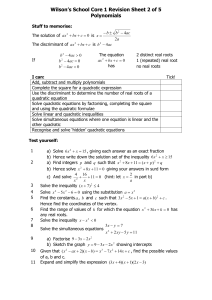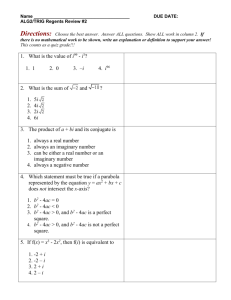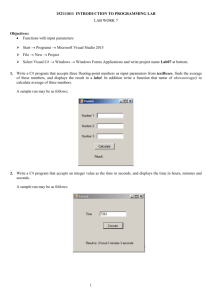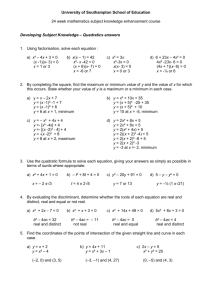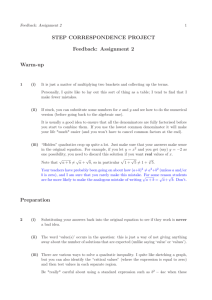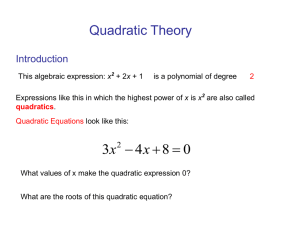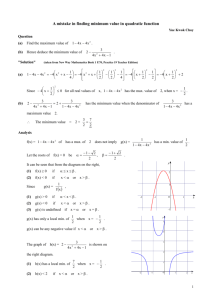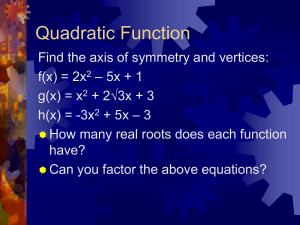Quadratic Functions
advertisement
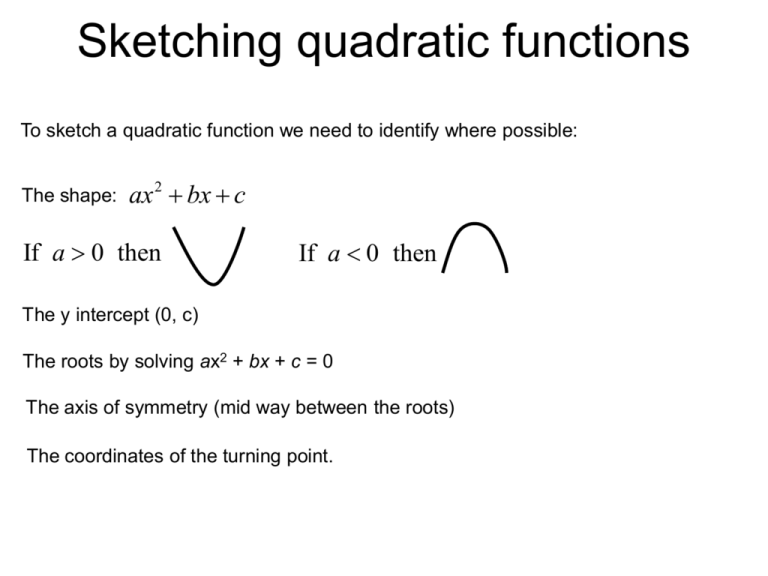
Sketching quadratic functions To sketch a quadratic function we need to identify where possible: The shape: ax 2 bx c If a 0 then If a 0 then The y intercept (0, c) The roots by solving ax2 + bx + c = 0 The axis of symmetry (mid way between the roots) The coordinates of the turning point. 1. Sketch the graph of y 5 4 x x 2 The shape 10 2 4 6 8 – 10 2 4 6 8 2– 10 4 6 8 10 2 4 6 8 The coefficient of x2 is -1 so the shape is The Y intercept (0 , 5) y (-2 , 9) 10 8 The roots 6 5 4x x 0 (5 x)(1 x) 0 2 4 2 – 10 – 8 (-5 , 0) (1 , 0) – 6 – 4 – 2 – 2 – 4 The axis of symmetry – 6 – 8 Mid way between -5 and 1 is -2 x = -2 The coordinates of the turning point When x 2, y 9 (-2 , 9) – 10 2 4 6 8 10 x Completing the square The coordinates of the turning point of a quadratic can also be found by completing the square. This is particularly useful for parabolas that do not cut the x – axis. REMEMBER y ax 2 bx c can be written in the form y a( x p)2 +q. Axis of symmetry x p Coordinates of turning point ( p, q). 1. Find the equation of the axis of symmetry and the coordinates of the turning point of y 2 x 2 8 x 9. y 2 x2 8x 9 2( x 2 4 x) 9 2( x 2)2 9 8 2( x 2)2 1 Axis of symmetry is x = 2 Coordinates of the minimum turning point is (2 , 1) 2. Find the equation of the axis of symmetry and the coordinates of the turning point of y 7 6 x x 2 . y x2 6x 7 ( x 2 6 x) 7 ( x 3)2 7 9 ( x 3)2 16 Axis of symmetry is x = 3 Coordinates of the maximum turning point is (3 , 16) Solving quadratic equations Quadratic equations may be solved by: The Graph Factorising Completing the square Using the quadratic formula 1. Solve 6 x 2 x 15 0 (2 x 3)(3x 5) 0 2x 3 0 3 x 2 3x 5 0 5 x 3 2. Solve x 2 4 x 1 0 This does not factorise. ax 2 bx c 0 a 1, b 4, c 1 4 16 4 x 2 4 20 2 42 5 2 2(2 5) 2 2 5 or 2 5 b b 2 4ac x 2a Quadratic inequations A quadratic inequation can be solved by using a sketch of the quadratic function. 1. For what values of x is 12 5 x 2 x 2 0? First do a quick sketch of the graph of the function. 12 5 x 2 x 2 (4 x)(3 2 x) Roots are -4 and 1.5 Shape is a -4 1.5 The function is positive when it is above the x axis. 3 4 x 2 2. For what values of x is 12 5 x 2 x 2 0? First do a quick sketch of the graph of the function. 12 5 x 2 x 2 (4 x)(3 2 x) Roots are -4 and 1.5 Shape is a -4 1.5 The function is negative when it is below the x axis. 3 4 x and x 2 The quadratic formula ax 2 bx c 0 b b 2 4ac x 2a 2 1. Solve 2 x 2 5x 1 0 compare with ax bx c 0 a 2, b 5, c 1 5 25 8 x 4 5 17 5 17 and 4 4 2.28 and 0.22 2. Solve x 2 6 x 9 0 a 1, b 6, c 9 compare with ax 2 bx c 0 6 36 36 x 2 60 2 3 From the above example when the number under the square root sign is zero there is only 1 solution. 3. Solve x 2 2 x 9 0 a 1, b 2, c 9 compare with ax 2 bx c 0 2 4 36 x 2 2 32 2 Since 32 is not a real number there are no real roots. From the above example we require the number under the square root sign to be positive in order for 2 real roots to exist. This leads to the following observation. If b2 4ac 0 the roots are real and unequal. If b2 4ac 0 the roots are real and equal. If b2 4ac 0 the roots are non-real. For the quadratic equation ax 2 bx c 0, b 2 4ac is called the DISCRIMINANT. 4. Find the nature of the roots of 4 x 2 12 x 9 0 a 4, b 12, c 9 b2 4ac 144 144 0 Since the discriminant is zero, the roots are real and equal. Using the discriminant We can use the discriminant to find unknown coefficients in a quadratic equation. 1. Find p given that 2 x 2 4 x p 0 has real roots. a 2, b 4, c p b2 4ac 16 8 p 0 8 p 16 p2 The equation has real roots when p 2. 3. Show that the roots of (k 2) x 2 (3k 2) x 2k 0 are always real. a (k 2), b (3k 2), c 2k 2 3k b2 4ac (4 12k 9k 2 ) 8k (k 2) 4 12k 9k 2 8k 2 16k k 2 4k 4 (k 2)2 (k 2)2 0 for all values of k. Since the discriminant is always greater than or equal to zero, the roots of the equation are always real. Conditions for tangency To determine whether a straight line cuts, touches or does not meet a curve the equation of the line is substituted into the equation of the curve. When a quadratic equation results, the discriminant can be used to find the number of points of intersection. If b2 4ac 0 there are two distinct points of intersection. If b 2 4ac 0 there is only one point of intersection. the line is a tangent to the curve. If b2 4ac 0 the line does not intersect the curve. 1. Prove that the line y 2 x 1 is a tangent to the curve y x 2 . Find the point of intersection. x2 2 x 1 x2 2 x 1 0 a 1, b 2, c 1 b2 4ac 4 4 0 Since the discriminant is zero, the line is a tangent to the curve. x2 2 x 1 0 ( x 1)2 0 x 1 y x2 1 Hence the point of intersection is (1 , 1). 2. Find the equation of the tangent to y x 2 1 that has gradient 2. A straight line with gradient 2 is of the form y 2 x k x2 1 2 x k x 2 2 x (1 k ) 0 a 1, b 2, c 1 k For tangency b2 4ac 0 4 4(1 k ) 0 4 4 4k 0 4k 0 k 0 Hence the equation of the tangent is y = 2x. 3. Find the equations of the tangents from (0,-2) to the curve y 8x 2 . A straight line passing through (0,-2) is of the form y mx 2 8 x 2 mx 2 y 8 x 2 mx 2 0 a 8, b m, c 2 For tangency b2 4ac 0 x m2 64 0 m2 64 m 8 Hence the equation of the two tangents are y = 8x – 2 and y = -8x - 2.
